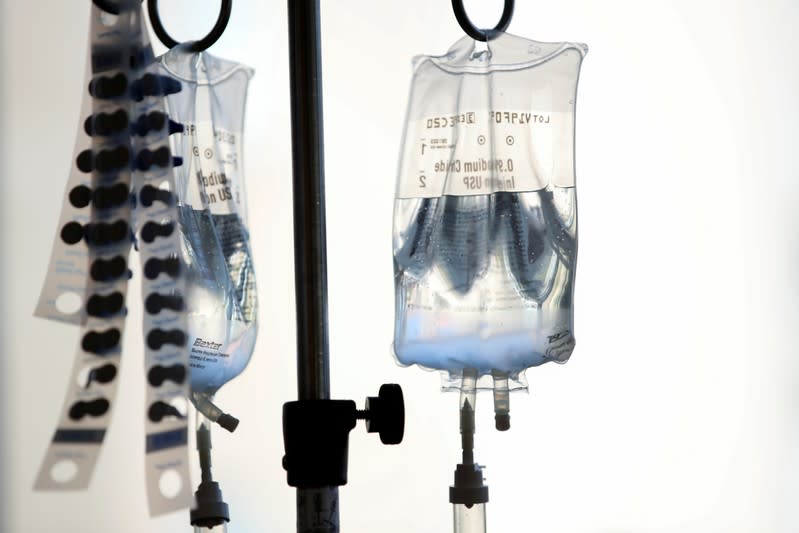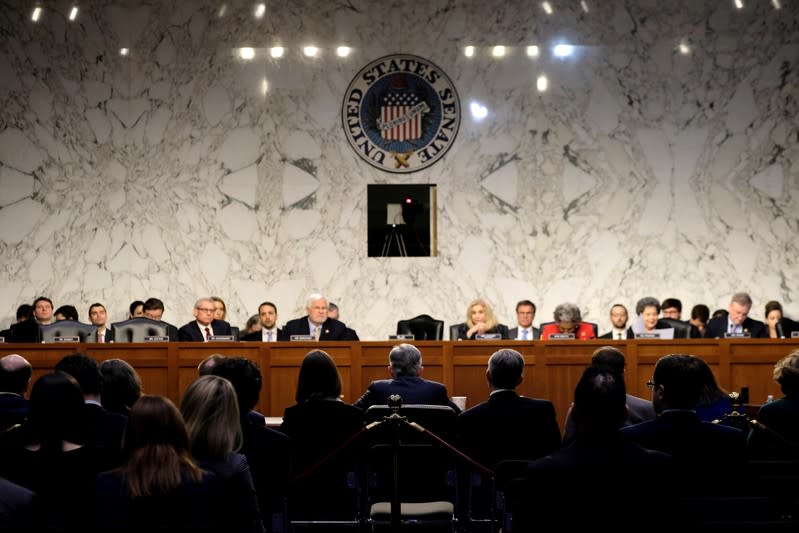Strong healthcare costs help to lift U.S. producer inflation
By Lucia Mutikani
WASHINGTON (Reuters) - U.S. producer prices increased by the most in six months in October, lifted by gains in the costs of goods and services, further bolstering the Federal Reserve's stance that it will probably not cut interest rates again in the near term.
The report from the Labor Department on Thursday showed healthcare costs accelerated last month, with the cost of outpatient care at hospitals posting its largest rise since 2009. The jump in healthcare prices mirrored gains reported in October's consumer price index report on Wednesday. Still, underlying producer inflation remained muted last month.
Stabilizing inflation follows in the wake of fairly upbeat data on the economy, including better-than-expected job growth in October and a pickup in services sector activity, which have eased financial market fears of a recession.
There have also been hopeful signs in the 16-year trade war between the United States and China, which has pressured business investment and manufacturing.
The U.S. central bank last month cut rates for the third time this year and signaled a pause in the easing cycle that started in July when it reduced borrowing costs for the first time since 2008. Fed Chair Jerome Powell again reiterated that position in testimony before lawmakers on Thursday.
"Inflation needs to accelerate noticeably for the Fed to consider raising interest rates, and that doesn't appear to be in the cards," said Ryan Sweet, a senior economist at Moody's Analytics in West Chester, Pennsylvania.
The producer price index for final demand rose 0.4% last month, the biggest increase since April, after falling 0.3% in September. In the 12 months through October, the PPI climbed 1.1%, the smallest increase since October 2016, after advancing 1.4% in the 12 months through September.
Annual producer inflation retreated as last year's hefty gain dropped out of the calculation. Economists polled by Reuters had forecast the PPI would rise 0.3% in October and climb 0.9% on a year-on-year basis.
Excluding the volatile food, energy and trade services components, producer prices edged up 0.1% after being unchanged in September. The so-called core PPI increased 1.5% in the 12 months through October after gaining 1.7% in the 12 months through September. Annual core PPI also slowed last month as last October's increase dropped out of the calculation.
The government reported on Wednesday that consumer prices rose solidly in October amid large gains in healthcare costs and prices of used cars and trucks.
The Fed, which has a 2% annual inflation target, tracks the core personal consumption expenditures (PCE) price index for monetary policy. The core PCE price index rose 1.7% on a year-on-year basis in September and has undershot its target this year. October PCE price data will be published later this month.
The dollar was little changed against a basket of currencies, while U.S. Treasury prices rose. Stocks on Wall Street were mixed.
SOLID LABOR MARKET
While another report from the Labor Department on Thursday showed the number of Americans filing claims for unemployment benefits rose to a five-month high last week, that likely does not signal a shift in labor market conditions as claims for several states were estimated because of Monday's holiday.
Initial claims for state unemployment benefits increased 14,000 to a seasonally adjusted 225,000 for the week ended Nov. 9, the highest reading since June 22. Some of the states, including California, Pennsylvania and Virginia, did not have enough time to process the claims data because of Monday's Veterans Day holiday, leading to them making estimates.
The four-week moving average of initial claims, considered a better measure of labor market trends as it irons out week-to-week volatility, rose only 1,750 to 217,000 last week.
"This cannot be viewed as anything but noise," said John Ryding, chief economist at RDQ Economics in New York. "We would not view claims as sending a troubling growth signal until the four-week average approaches 250,000."
Labor market strength, marked by the lowest unemployment rate in nearly 50 years, is supporting consumer spending and helping to offset some of the hit on the economy from the U.S.-China trade war.
In October, wholesale energy prices rebounded 2.8% after dropping 2.5% in September. They were boosted by a 7.3% surge in gasoline prices, which followed a 7.2% decline in September.
Gasoline accounted for nearly half of the 0.7% increase in goods prices last month. Goods prices fell 0.4% in September.
Wholesale food prices jumped 1.3% in October after rising 0.3% in September. There was still no sign that the trade tariffs were boosting producer inflation, with core goods prices unchanged last month after slipping 0.1% in September.
The cost of services increased 0.3% last month, reversing September's 0.2% decrease. Services were lifted by a 0.8% surge in trade services, which measure changes in margins received by wholesalers and retailers.
There were also increases in the cost of healthcare services, which accelerated 0.8% after gaining 0.3% in the prior month. The cost of hospital outpatient care jumped 0.7%, the most since July 2009. Inpatient care prices rose 0.6%, the biggest increase since October 2018. Those healthcare costs feed into the core PCE price index.
But portfolio management fees, which also go into the calculation of the core PCE price index fell 0.9% after being unchanged in September. That led economists to expect that the core PCE price index gained 0.2% in October following a flat reading in September. The annual increase in the Core PCE price index is seen steady at 1.7% in October.
(Reporting by Lucia Mutikani; Editing by Paul Simao)


